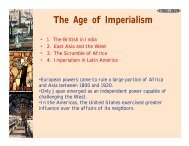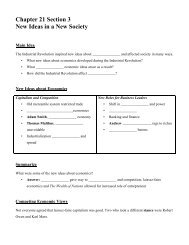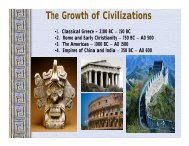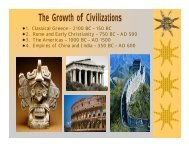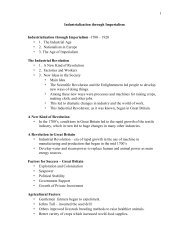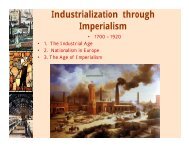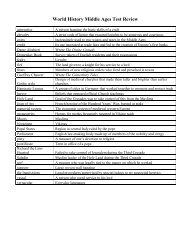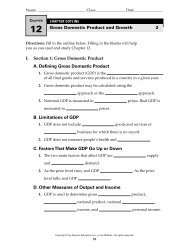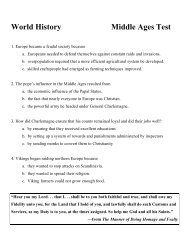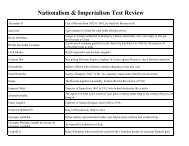Chapter 7: Market Structure
Chapter 7: Market Structure
Chapter 7: Market Structure
Create successful ePaper yourself
Turn your PDF publications into a flip-book with our unique Google optimized e-Paper software.
<strong>Chapter</strong> 7: <strong>Market</strong> <strong>Structure</strong><br />
• 1. Perfect Competition<br />
• 2. Monopoly<br />
• 3. Monopolistic Competition and Oligopoly<br />
• 4. Regulation and Deregulation<br />
How How does does Competition<br />
Competition<br />
affect affect your your choices? choices?<br />
Property Management Software. Real-Estate-Google-Monopoly<br />
http://www.trexglobal.com. (accessed October 2, 2010).
1. Perfect Competition<br />
• The simplest market structure in which a large number of<br />
firms all produce the same product an no single seller<br />
controls supply or price<br />
New York Stock<br />
Exchange<br />
Street Vendors<br />
Fishing <strong>Market</strong>,<br />
Vegetable or fruit<br />
vendors<br />
Free Software
New York Stock Exchange<br />
• A Stock Exchange located at 11 Wall Street Lower Manhattan, NYC<br />
• Largest by market capitalization of its listed companies at $11.92 trillion as of Aug<br />
2010
Four Conditions<br />
• Many Buyers and<br />
Sellers participate in<br />
the market<br />
• Sellers offer identical<br />
products- commodity -a<br />
product that is the<br />
same no matter who<br />
produces or sells it<br />
• Examples notebook<br />
paper, paper clips,<br />
sugar, low grade<br />
gasoline<br />
• Buyers and Sellers are<br />
well informed<br />
• Sellers are able to<br />
enter and exit the<br />
market freely<br />
Informed<br />
Buyers and<br />
Sellers<br />
Free <strong>Market</strong><br />
Entry and Exit<br />
Many Buyers<br />
And Sellers<br />
Perfect<br />
Competition<br />
No control<br />
Over Price<br />
Identical<br />
Products
Barriers to Entry<br />
• Any factor that<br />
makes it difficult<br />
for a new firm to<br />
enter a market<br />
• Imperfect<br />
competition - a<br />
market structure<br />
that fails to meet<br />
the conditions of<br />
perfect competition<br />
Perfect<br />
Competition<br />
• Start-Up Costs -<br />
expenses a new<br />
business must pay<br />
before it can begin<br />
to produce and sell<br />
goods<br />
• Technology -need a<br />
lot of preparation<br />
and study<br />
Number of Firms:<br />
Many<br />
Variety of Goods:<br />
None<br />
Barriers to Entry:<br />
None<br />
Control over Prices:<br />
None
Price and Output<br />
• Competition within Perfect Competition market keep both<br />
prices and production costs low<br />
P<br />
r<br />
i<br />
c<br />
e<br />
10<br />
5<br />
Equilibrium<br />
Price<br />
<strong>Market</strong> Equilibrium in<br />
Perfect Competition<br />
Demand<br />
Equilibrium<br />
Quantity<br />
Supply<br />
What factors<br />
allow a perfectly<br />
competitive<br />
market to reach<br />
equilibrium?<br />
What prevents<br />
any on firm from<br />
raising its<br />
prices?<br />
0<br />
5<br />
Quantity (Output)<br />
10
2. Monopoly<br />
• A market in which a single seller dominates<br />
• Economies of Scale -factors that cause a producer’s average<br />
cost per unit to fall as output rises<br />
• Natural monopolies -a market that runs most efficiently<br />
when one large firm provides all of the output<br />
• Technology and Change – can ruin monopolies (example AT&T<br />
to cell phones)<br />
To prevent resources<br />
from being wasted,<br />
public water is a natural<br />
monopoly.<br />
Nivangune, Geetai, A<br />
Clean Desk=A Healthier<br />
You, Medimanage.com<br />
(accessed October 2,<br />
2010
Effects on Economies Of Scale<br />
• Average Total Cost Curve<br />
Without Economies of<br />
Scale<br />
• Average Total Cost Curve<br />
With Economies of Scale<br />
C<br />
o<br />
s<br />
t<br />
Average<br />
Costs Rises<br />
when output<br />
exceeds a<br />
certain level.<br />
C<br />
o<br />
s<br />
t<br />
Average Costs<br />
of production<br />
falls when firms<br />
produce more<br />
Output<br />
Output<br />
Why do production costs fall as output increases? Describe the cost<br />
curve for a firm without economies of scale.
Perfect Competition vs.<br />
Monopoly<br />
How are monopolies similar to perfect competition?<br />
Different?<br />
Perfect<br />
Competition<br />
Monopoly<br />
Number of Firms:<br />
Many<br />
Variety of Goods:<br />
None<br />
Barriers to Entry:<br />
None<br />
Control over Prices:<br />
None<br />
Number of Firms:<br />
One<br />
Variety of Goods:<br />
None<br />
Barriers to Entry:<br />
Complete<br />
Control over Prices:<br />
Complete
Government Monopolies<br />
• A Monopoly created by the government<br />
• A Patent - license giving inventor exclusive right for a specific<br />
period of time<br />
• Franchise -a contract that gives a single firm the right to sell its<br />
goods within an exclusive market<br />
• License -gov’t issued right to operate a business<br />
• Industrial Organizations -Major League Baseball
Output Decisions<br />
• Monopolies face limited<br />
choice –either output or<br />
price<br />
• Monopolistic Dilemma -if<br />
a company produces<br />
more, the price will fall,<br />
if it produces less, the<br />
price will rise<br />
• Falling Marginal Revenueif<br />
company decrease<br />
price, demand will<br />
increase, but marginal<br />
revenue will decrease<br />
• Setting a Price -<br />
Marginal revenue is<br />
slightly higher than the<br />
price<br />
Price<br />
Demand Schedule for a Product<br />
Week<br />
Demand<br />
Total<br />
Revenue<br />
Change<br />
in Rev<br />
$12 8,000 $96,000 --- ---<br />
$11 9,000 $99,000 $3,000 $3<br />
$10 10,000 $100,000 $1,000 $1<br />
$9 11,000 $99,000 $-1,000<br />
$-1<br />
$8 12,000 $96,000 -3,000$<br />
$-3<br />
Marginal<br />
Revenue
Why does revenue fall production increases from 10,000 to 11,000?<br />
How does producing fewer goods benefit a monopolist?<br />
Output Decisions<br />
• When 8,000 doses are made, the<br />
market price is 12.<br />
Price<br />
Demand Schedule for a Product<br />
Week<br />
Demand<br />
Total<br />
Revenue<br />
Change<br />
in Rev<br />
Marginal<br />
Revenue<br />
P<br />
r<br />
i<br />
c<br />
e<br />
s<br />
12<br />
10<br />
8<br />
$12 8,000 $96,000 --- ---<br />
$11 9,000 $99,000 $3,000 $3<br />
$10 10,000 $100,000 $1,000 $1<br />
$9 11,000 $99,000 $-1,000<br />
$-1<br />
0<br />
8 10 12<br />
Output<br />
•As production rises to 11,000<br />
doses, the price falls to $9.<br />
$8 12,000 $96,000 -<br />
3,000$<br />
$-3
Price Discrimination<br />
• The division of consumers into groups based on how much they will pay for<br />
a good<br />
• <strong>Market</strong> Power -ability to control prices and total market output<br />
• Targeted Discounts -discounted airline fares, Manufacturers’ Rebates,<br />
Senior citizen discounts, children . . . free<br />
P<br />
r<br />
i<br />
c<br />
e<br />
$11<br />
$3<br />
<strong>Market</strong><br />
Price<br />
b<br />
a<br />
Demand<br />
Marginal Cost<br />
Marginal Revenue<br />
c<br />
Setting a<br />
Price in a<br />
Monopoly<br />
How does<br />
Point C show<br />
the benefits<br />
to consumers<br />
in a perfectly<br />
competitive<br />
market?<br />
0 9,000<br />
Output
Limits of Price Discrimination<br />
• <strong>Market</strong> must meet three conditions<br />
• Some market Power -must have some control<br />
• Distinct Customer Groups – seniors v. citizens<br />
• Difficult resale-
3. Monopolistic Competition and<br />
Oligopoly<br />
• A market structure<br />
in which many<br />
companies sell<br />
products that are<br />
similar but not<br />
identical<br />
• Different from<br />
perfect competition<br />
because products<br />
are not similar<br />
• Examples – Jeans,<br />
bagel shops, ice<br />
cream stands, gas<br />
stations, retail<br />
store<br />
Like, NO,Tyler, I would<br />
never go out with you!<br />
•Jeans are an example<br />
of monopolistic<br />
competition because<br />
jeans can vary size,<br />
color, style, and<br />
designer<br />
•“Are those bugle boy<br />
jeans you are<br />
wearing.”
Four Conditions<br />
• Many firms -not<br />
marked by economies<br />
of scale<br />
• Few article barriers to<br />
entry<br />
• Little control over<br />
price -will buy others<br />
if price rises<br />
• Differentiated<br />
products -making a<br />
product different from<br />
others, but similar<br />
Monopolistic<br />
Competition<br />
Number of Firms:<br />
Many<br />
Variety of Goods:<br />
Somed<br />
Barriers to Entry:<br />
Low<br />
Control over Prices:<br />
Limited
Non price Competition<br />
• A way to attract customers through style, service, or location, but not<br />
at a lower price<br />
• Physical characteristics -running shoes, pens, cars, and toothpaste<br />
• Location -will fail or succeed based on location<br />
• Service Level -fast food, dinners<br />
• Advertising, image, or status – designer names<br />
•The designer athletic shoes<br />
are way more expensive than<br />
the sensible sneakers, but<br />
you buy them anyways.<br />
•Status along with designer<br />
shoe is a form of non price<br />
competition<br />
•Wawa is closer to Mr.<br />
Schenk’s house than Giant.<br />
For a late night snack, he<br />
will go to Wawa for peanut<br />
butter cups, even though<br />
they are cheaper at Giant
Prices, Output, and Profits<br />
• Prices – competition curves raising prices<br />
• Output – falls pretty fairly<br />
• Profits – earn just enough to cover costs
Oligopoly<br />
• A market structure in<br />
which a few large<br />
firms dominate a<br />
market<br />
• <strong>Market</strong>s for air<br />
travel, automobiles,<br />
breakfast cereals,<br />
and household<br />
appliances<br />
• Pepsi, Coke, Coca Cola<br />
Oligopoly<br />
Number of Firms:<br />
A Few<br />
Variety of Goods:<br />
Some<br />
Barriers to Entry:<br />
High<br />
Control over Prices:<br />
Some
Oligarchy<br />
• Barriers to entry -technological or<br />
through government licenses or<br />
patents-high start up costs<br />
• Price Wars -a series of competitive<br />
price cuts that lowers the market<br />
price below the cost of production<br />
• Collision – illegal agreement among<br />
firms to divide the market<br />
• Price fixing- an agreement among<br />
firms to charge one price for the<br />
same good<br />
• Cartel -a formal organization of<br />
producers that agree to coordinate<br />
prices and production<br />
The U.S. government decides to go after an agri-business giant with a price-fixing<br />
accusation, based on the evidence submitted by their star witness, vice president<br />
turned informant Mark Whitacre Mark Whitacre has worked for lysine developing<br />
company ADM for many years and has even found his way into upper management. But<br />
nothing has prepared him for the job he is about to undertake - being a spy for the<br />
FBI. Unwillingly pressured into working as an informant against the illegal price-fixing<br />
activities of his company, Whitacre gradually adopts the idea that he's a true secret<br />
agent. But as his incessant lies keep piling up, his world begins crashing down around<br />
him
The OPEC Cartel<br />
Share of Total Oil<br />
Reserves<br />
Who controls most of<br />
the oil reserves? How<br />
about the least? How<br />
does that affect the<br />
United States?<br />
• The Organization of Petroleum<br />
Exporting Countries (OPEC) is an<br />
international cartel of major oil<br />
producers. OPEC members produce<br />
about 40% of the world’s oil and control<br />
about 75% of the world’s oil reserves.<br />
Members meet regularly to set<br />
production quotas. Most experts agree<br />
that world oil supplies are not<br />
sufficient to meet increased demand.<br />
In 2008, Libya’s OPEC delegation made<br />
a prediction: “The easy, cheap oil is<br />
80over.”<br />
70<br />
60<br />
50<br />
40<br />
30<br />
20<br />
10<br />
0<br />
1st<br />
Qtr<br />
European<br />
Union<br />
OPEC<br />
Non-OPEC<br />
Russia
Powerful trusts in the late 1800’s led Congress to pass antitrust<br />
legislation.
4. Regulation and Deregulation<br />
• Sometimes the government<br />
takes steps to promote<br />
competition because<br />
markets with more<br />
competition have lower<br />
prices.<br />
• <strong>Market</strong> Power -ability of a<br />
firm to control prices and<br />
total output<br />
• Predatory Pricing -selling a<br />
price below cost for a short<br />
period of time to drive<br />
competition out
Government and Competition<br />
• Sherman Anti Trust – laws that encouraged competition<br />
in the market place<br />
• Government broke up monopolies<br />
• Blocking Mergers -when two or more companies join to<br />
form single firm<br />
Key Events in Federal AntiTrust Policy<br />
Date<br />
Event<br />
1901 Theodore Roosevelt became President and begins<br />
enforcing the 1890’s s Sherman AntiTrust Act, which<br />
outlaws mergers and monopolies that restrain trade<br />
between states.<br />
1911 Supreme Court breaks up Rockefeller’s s Standard Oil<br />
Trust Company<br />
1950 Celler-Kefauver Act allows government to stop<br />
mergers that could hurt competition<br />
1982 AT&T agrees to break up its local phone service into<br />
several companies<br />
2001 Department of Justice settles its lawsuit with<br />
Microsoft.
Deregulation<br />
• The removal of some government controls over a market<br />
• Decided in the late 1970’s, Congress deregulated some of<br />
the market because it was reducing competition.<br />
• Deregulated the airlines, trucking, banking, railroad, natural<br />
gas, and television broadcasting industries<br />
Regulation and Deregulation<br />
Government Passes Antitrust Laws<br />
Laws are used to regulate business<br />
New laws limit unfair business<br />
Deregulation promotes competition
Comparison of <strong>Market</strong><br />
<strong>Structure</strong>s<br />
Perfect<br />
Competition<br />
Monopolistic<br />
Competition<br />
Oligopoly<br />
Monopoly<br />
Number of<br />
Firms<br />
Many<br />
Many<br />
A Few<br />
Dominate<br />
One<br />
Variety of<br />
Goods<br />
None<br />
Some<br />
Some<br />
None<br />
Control over<br />
Prices<br />
None<br />
Little<br />
Some<br />
Complete<br />
Barriers to<br />
Entry<br />
None<br />
Low<br />
High<br />
Complete<br />
Examples<br />
Wheat,<br />
Shares of<br />
stock<br />
Jeans, Books<br />
Cars, Movie<br />
Studios,<br />
Soda<br />
Companies<br />
Public Water



